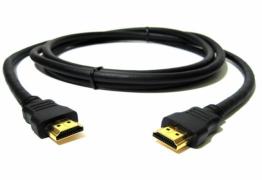An Overview of HDMI
As discussed in our post “The Transition to the Digital Age,” analog signals and cables will soon be a thing of the past. VGA (Video Graphics Array) outputs – the long time industry standard for laptop and portable devices, will be replaced. The most common replacement for VGA is HDMI (High-Definition Multimedia Interface), which first began being used for video transmission in 2003. HDMI is the first all-digital audio/video interface that has been accepted and supported throughout the electronics industry and will be commonplace in Rutgers classrooms.
As the industry began moving away from analog to digital connection, television resolutions increased to high-definition format. The HDMI cable was designed to be an “all-in-one” cable, combining uncompressed audio and video for maximum picture quality. HDMI can pass video resolutions from 480i up to 1080p. HDMI can be used with televisions, AV receivers, DVD Players, Blu-ray disc players, cable boxes, and projectors. HDMI also includes provisions for HDCP (High Definition Copy Protection). This allows content providers to prevent their programming from being illegally copied.
The HDMI format is constantly evolving to stay apace with the needs of emerging media technologies. The latest version, 1.3, adds additional support for a greater array of digital audio processing. Newer versions of the HDMI specifications will continue to be fully backward compatible with earlier HDMI products, so there is no need to have to go out and buy a product with the latest version.
Although laptops and computers were never the primary focus for HDMI, the size and design characteristics that are ideal for televisions and media also apply to laptops and mobile devices. The connector is thinner and flatter from the standard VGA cable making HDMI great for laptops and other small devices. As a result, HDMI is the most prevalent output on newer laptops. Accordingly, DCS is working to introduce HDMI connections to all Rutgers classrooms. To see if your classroom has a HDMI input available for connecting a mobile device, search for your room, and check the "Additional Items" listed on the "Classroom Features" tab.
